- Get link
- X
- Other Apps
- Get link
- X
- Other Apps
The history of deforestation in the Highlands is long, complex and shrouded in mystery, but we can still gain glimpses of what has been lost.
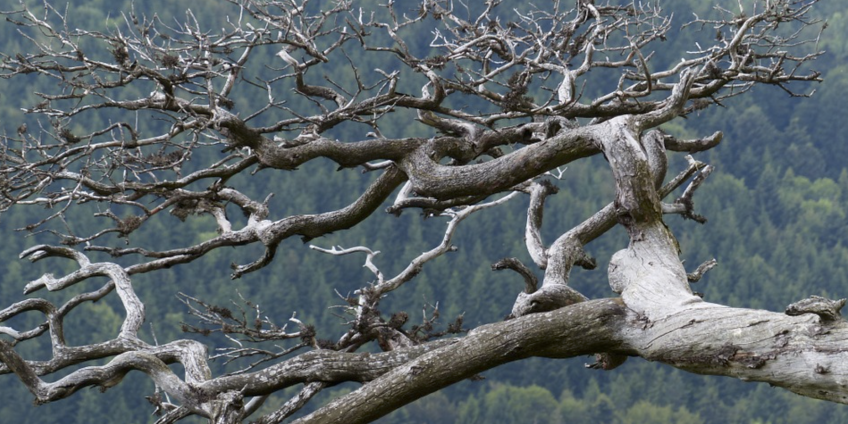
Deforestation is a global problem. We are rightly concerned about the current destruction of forests in other parts of the world, but it isn't always so apparent that humans have been clearing Scottish woodlands for millennia. In Scotland only a tiny fraction of our original native forest cover remains. The history of this deforestation in the Highlands is long, complex and shrouded in mystery, but we can still gain glimpses of what has been lost.
The ice retreats
14,000 years ago, if we were to visit Glen Affric, or many other glens in the Highlands, we would find a wild, open treeless tundra, a desert of glacier-scoured rock with glaciers still remaining in the corries. By 12,000 years ago the warming climate forced the glaciers to retreat further still. Hardy shrubs such as dwarf birch, willows and juniper began to get a foothold, as well as hazel, aspen, birch, pine and other tree species.All the while, plants, fungi, mammals and many other organisms colonised from further south. At this point Britain was still attached to the rest of Europe; so much water was still locked up in ice, the English Channel hadn't yet formed.
Scotland's ancient forest
The peak for Scotland's woodlands was about 5,000 years ago, when tree cover and diversity was at its greatest extent. The 'Caledonian Forest' is a poetic name, from a Latin word meaning 'wooded heights'. We know that it was not a dense blanket of pine woodland as was once thought, although native pinewoods were an important component of this forest. Here we use the term to refer to the vast, primeval wilderness that spread across about 1.5 million hectares of the Highlands. No one knows for sure what this wilderness was like, and it is the subject of considerable debate and speculation, but pollen records and comparisons with wild forests in other countries can help us paint a picture.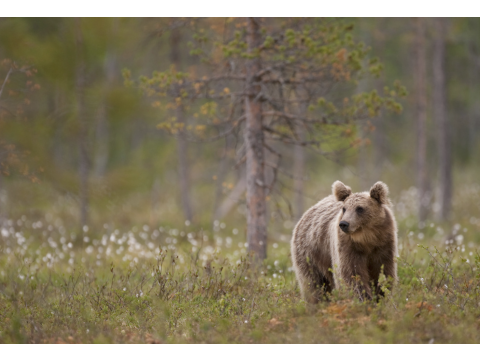 Wildlife flourished. Lynx prowled the denser forest, packs of wolves hunted deer, giant wild cattle (known as aurochs) grazed open glades, while boar rooted through the leaf litter. Bears scooped salmon from the rivers, and elk grazed in the willow meadows created by the dams of beavers.Woodlands
covered a large area of the land and the forest was rich and diverse.
It is likely that the structure of the forest was very varied, and
included a mosaic of denser woodland, open 'savannahs' and different
kinds of scrub, as well as open heaths and bogs, which were an important
part of the whole matrix. Among the many tree species were Scots pine,
aspen, birch, oak, rowan, holly, willow and alder.
There would have been a wide range of woodland types: pine woods, alder
swamps, elm and ash woods, birchwoods and others which may have been
completely lost. Each would have had unique communities of specialist
wildlife. Open ground added to the diversity, and woodland would shift
and change with no fixed boundaries.
Wildlife flourished. Lynx prowled the denser forest, packs of wolves hunted deer, giant wild cattle (known as aurochs) grazed open glades, while boar rooted through the leaf litter. Bears scooped salmon from the rivers, and elk grazed in the willow meadows created by the dams of beavers.Woodlands
covered a large area of the land and the forest was rich and diverse.
It is likely that the structure of the forest was very varied, and
included a mosaic of denser woodland, open 'savannahs' and different
kinds of scrub, as well as open heaths and bogs, which were an important
part of the whole matrix. Among the many tree species were Scots pine,
aspen, birch, oak, rowan, holly, willow and alder.
There would have been a wide range of woodland types: pine woods, alder
swamps, elm and ash woods, birchwoods and others which may have been
completely lost. Each would have had unique communities of specialist
wildlife. Open ground added to the diversity, and woodland would shift
and change with no fixed boundaries.Climatic changes
Forests respond to natural changes in climate, and around 4,500 years ago, a period of cold, wet weather began, encouraging the spread of peat bogs. Pollen studies suggest that in some areas, especially the north and west, this was not so favourable for tree growth. The treeline became lower, and in the wettest areas pine retreated and was replaced by scattered broadleaves - the area of bog also increased. It is not clear to what extent humans were involved at this point, although after this climatic fluctuation, some suggest that woodland would have regained old ground as the cold, wet period ended. Overall there was still a vast network of woodland at this point, mixed with heath, bog and scrub.The arrival of farming
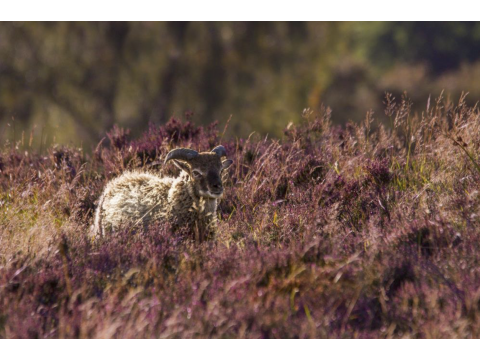 Early
farmers arrived in these areas about 3,900 years ago (although humans
were present much earlier, and their impact is unknown). These farmers
had grazing animals - cattle, goats and primitive sheep. In areas they
burned the heath and resinous pinewoods to encourage fresh growth of heather
for their stock. The combination of burning and grazing forced woodland
into further retreat as well as preventing it recolonising bare areas.
It is impossible to know for sure the exact effect these farmers had,
but their activities profoundly altered the ecosystem. It is likely that
they would have been attracted to the more open woodlands for grazing
their animals, accelerating the cycle of overgrazing and deforestation.
Early
farmers arrived in these areas about 3,900 years ago (although humans
were present much earlier, and their impact is unknown). These farmers
had grazing animals - cattle, goats and primitive sheep. In areas they
burned the heath and resinous pinewoods to encourage fresh growth of heather
for their stock. The combination of burning and grazing forced woodland
into further retreat as well as preventing it recolonising bare areas.
It is impossible to know for sure the exact effect these farmers had,
but their activities profoundly altered the ecosystem. It is likely that
they would have been attracted to the more open woodlands for grazing
their animals, accelerating the cycle of overgrazing and deforestation.Through the centuries, trees were felled for timber, fuel and to make way for agriculture. What is more, grazing of domestic livestock severely limited the scope for regeneration. The forest was forced into smaller, fragmented pockets. Even in the wetter areas, it is likely that humans exacerbated the effects of climate. For example, removing even scattered trees affects the hydrology of the land. Trees draw up a huge amount of water from the ground, so their loss would have increased waterlogging, making the land less suitable for tree growth. Similarly, removing trees takes away important seed sources and removes the source of leaf litter which itself plays a key role in converting peat to soils more favourable for tree growth.
By the time the Romans arrived, over half of our native forests had been lost. Some historical accounts suggest that the forest was a huge unbroken blanket of woodland at the time, although this is a myth, as it had in fact already been hugely depleted, and was never really a solid 'blanket' in the first place.
Various kinds of exploitation continued down the centuries. During the Middle Ages, the Vikings are said to have burned areas of forest as part of their campaigns. However, as pine woodland can regenerate well in response to fire, this would only have caused lasting damage in wetter areas, where regeneration was slower, and in areas subject to heavy grazing by livestock. It was pastoral activity - fire and teeth - that was the most consistently destructive human activity. Overgrazing would also have amplified the effects of periods of climatic deterioration, such as the 'Little Ice Age', which began in the fourteenth century. There are reports of areas of forest being burned specifically for the purpose of eradicating wolves.
By the 18th century, woodland cover reached its all time low. While many pinewood remnants continued to be exploited, the fragments were sometimes protected from overgrazing to ensure a supply of timber. These remaining fragments became really vulnerable when competition from Scandinavia and the Baltic states undermined the timber market. There was then little incentive to protect them from overgrazing, and with the rise of deer numbers for sporting estates, their deterioration continued.
The rise in sheep farming, the increased numbers of deer for sporting estates, and the practice of muirburn on grouse moors in recent centuries have all pushed the forest into further decline. Around the 18th Century cheap timber imports meant that there was little incentive to protect pinewood fragments from overgrazing.
The rise of forestry
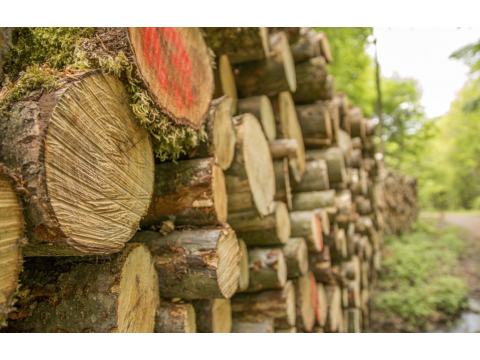 Both
of the World Wars took a heavy toll on the remains of our native
forests. Following the First World War it was recognised that Britain
had almost run out of timber. The Forestry Commission was established in
1919 to prevent the same situation happening again, and its key purpose
was to help Britain become self reliant in timber.
Both
of the World Wars took a heavy toll on the remains of our native
forests. Following the First World War it was recognised that Britain
had almost run out of timber. The Forestry Commission was established in
1919 to prevent the same situation happening again, and its key purpose
was to help Britain become self reliant in timber.Fast-growing introduced species such as Sitka spruce were used to create dense plantations which tend to support a very limited range of wildlife compared to ancient, native forests. Areas of native woodland were both felled and underplanted, and so shaded out by the introduced trees. At the time conservation wasn't high up the political agenda, and many native woodlands were damaged or lost as a result.
Priorities have since changed and the Forestry Commission has carried out a great deal of excellent work to reverse the situation, and is protecting and restoring native woodlands on a large scale, as well as increasing the diversity within plantations.
The ecological effects of deforestation
Such large-scale, long-term ecological destruction has totally transformed the Scottish Highlands, and now only around 1% of our native pinewoods remain, while many other habitats have been degraded or lost. All of our woodlands have been influenced by humans in some way and the ecological effects have been complex and varied; some of the key ones are outlined below:When a habitat is fragmented, as is now the case, the species within the isolated patches become more vulnerable to inbreeding and disturbance such as fire and disease. Connectivity is essential for the robustness of an ecosystem.
Large, wild forests are dynamic habitats which exhibit ecological processes such as succession, and are influenced by natural disturbances such as fire, storms and disease. These keep the overall ecosystem vary varied, with plenty of different habitats. Small, fragmented woodlands cannot withstand disturbance in the same way, and the ecosystem becomes less complex.
Not only has woodland cover been lost, but overgrazing in the remnants has also selected out the most palatable species, especially aspen, holly, rowan and juniper, which in turn affects the specialist species that depend on them. Native woodland remnants are therefore less diverse than they would otherwise be.
A number of key wildlife species have been lost, because of both habitat destruction and direct persecution. This has had a catastrophic effect, since all the animals and other life forms that dwell in the forest play a crucial role in keeping this diverse ecosystem healthy and robust. When key species are removed, the tapestry begins to unravel, affecting the health of the whole system.
By catching fish in streams and eating them on land, bears redistribute nutrients from aquatic to terrestrial ecosystems. This flow of nutrients was broken with the extirpation of bears about 1,000 years ago.
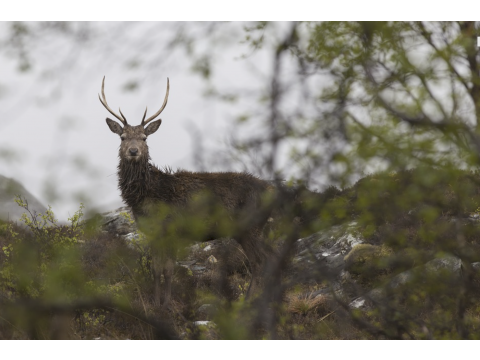 The top predators
- wolf, bear and lynx - were all hunted to extinction by humans, as
were beaver, aurochs, elk and wild boar. These animals each had an
important, unique influence on the forest, keeping it rich and diverse.
For example, predators keep herbivore
numbers in check - a lack of natural predators is a major reason why
deer numbers are now damagingly high. Herbivores' feeding habits in turn
create a varied structure in the forest, along with many other
important effects. Numerous other, less obvious creatures have also been
lost or had their numbers drastically reduced.
The top predators
- wolf, bear and lynx - were all hunted to extinction by humans, as
were beaver, aurochs, elk and wild boar. These animals each had an
important, unique influence on the forest, keeping it rich and diverse.
For example, predators keep herbivore
numbers in check - a lack of natural predators is a major reason why
deer numbers are now damagingly high. Herbivores' feeding habits in turn
create a varied structure in the forest, along with many other
important effects. Numerous other, less obvious creatures have also been
lost or had their numbers drastically reduced.Deforestation has also caused changes in the structure and fertility of the soil. Woodlands are more effective at retaining nutrients than overgrazed grassland, and so the loss of woodland cover can result in the soil becoming impoverished. Trees also intercept rainfall, and send moisture back into the atmosphere via a process known as transpiration. With loss of tree cover, waterlogging and erosion can both occur. In upland areas, when nutrients are leached from the soil a dense layer called an iron pan can form in the soil, again increasing waterlogging and making the ground inhospitable to trees.
Centuries of farming that involves rearing then removing animals from the land, means that high concentrations of nutrients have been lost when the meat was sold elsewhere (eg in towns and cities).
Dead wood, standing and fallen, is a vital part of a healthy forest, supporting a wide range of organisms. Forest clearance, and intensive management of forests has resulted in a huge decrease of this crucial resource.
Deforestation and overgrazing also result in the loss of the shrub layer and changes to the ground flora. When the structure becomes simplified, there are fewer niches for wildlife. Where areas may formerly have had rich floral communities, overgrazing and loss of the canopy can reduce the vegetation to a handful of grasses and other species that are much more peat-tolerant. This accelerates the formation of peat and blanket bog, which are hostile to trees. While, as noted above, bogs can form naturally due to climate, and are a valuable part of the landscape mosaic, human interference has created an unnaturally high proportion of species-poor, waterlogged ground, where woodland would otherwise have thrived.
A Forest for the Future
As we have seen, there is much that isn't known about the forest's history, or the exact impact humans had at particular times, although research is always giving rise to new insights and ideas. We do know, however, that humans have drastically denuded and degraded the forest over millennia, and forest cover has fluctuated with climatic changes. While no one can say for certain what the forest would be like had humans never interfered, we can safely say that it would be much more extensive and connected, and would contain a much richer array of wildlife than it does at present.So what is the future for the forest? Most forest remnants are still struggling to expand, or even survive, largely because of overgrazing by excessive numbers of deer and sheep. Encouragingly, there is now a huge interest in restoring native woodlands in Scotland, with many individuals and organisations playing their part. We have space to do this on a large scale while maintaining important areas of open ground, which can themselves be valuable habitats.
There is a need for a wide range of forest uses, including the provision of timber and other forest products. To balance this, there is also the need for large wild areas free of intensive human management - 'self-willed land', to use a term coined by ecologist Aldo Leopold.
Trees for Life's vision is to restore a large area of wild diverse forest, which would include a wide range of habitats, to the Scottish Highlands. The aim is not to recreate a forest of the past. Even if we knew what past forests were really like, forests are ever-changing ecosystems. The goal is to restore the key elements in the forest to allow evolution and natural processes a freer reign. There is no doubt that the presence of wild forests nourish the human spirit, as well as being essential to the health of the Earth.
Comments
Post a Comment